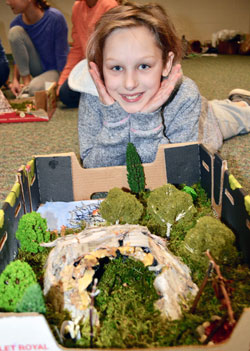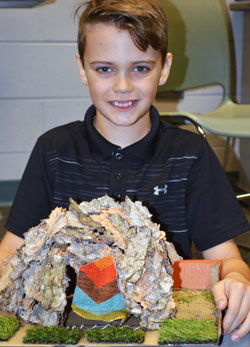The fifth grade social studies curriculum includes five weeks of study of Native American history and culture. SNN recently spent time in two classrooms as students worked.
Breton Downs Elementary
As part of teacher Bridget Rieth’s Native American unit, fifth-graders created their own primary source documents based on Lakota “winter counts.”
The counts were — and for some Plains indians, still are — events considered notable that were usually painted onto an animal hide, and served as historical records of the culture.
Rieth said she wants students to get at the larger question of “Why does Native American culture and history matter?”

That was easy for Owen Cavera, who said “Because it shaped the history of the world.”
Learning to collaborate with others was a big part of the unit, Rieth said. Her students also broke into groups and researched a particular region and its Native American population. Each group created one three-dimensional item members thought best represented their region’s culture.
Oliver Chu’s group brainstormed a model of a teepee like those used by Great Plains Indians. His buddy Henry Kujawski’s group planned to construct a diorama of a hunting scene in the Southwestern region.
Also at Breton, each student made their own project to add to their group’s exhibit. Examples were models of homes, traditional foods, tools and clothing.
“Explicit instruction and practice with collaborative protocols is important as students develop their social, civic and work readiness skills,” Rieth said. “Our Native American study is a great time to focus on these skills.”

Lakeside Elementary
For the second year, Brett Scheidel’s students applied STEM principles to their unit on Native Americans. Fifth-graders worked alone or in teams of two or three to create dioramas of First Nations groups in regions they studied.
Delilah Scott’s diorama was a detailed scene of Eastern Woodland Iroquois. It included a wigwam of birch bark, “which was really common there,” she said. Her diorama also depicted deer meat roasting over an open fire, a bow and arrow, a canoe and a gill net thrown in the shallow end of a lake.
Riane Anderzejewski, Piper Vydareny and Chloe Custer constructed a teepee using paper towel to simulate animal hides. The Plains Cheyenne would have used hides rather than bark, because “they were very short on trees in the plains!” Piper explained.

The next step was to test the structures to see how they had to withstand severe weather in those regions.
“A big part of this (STEM project) was to be able to show how the First People adapted to their environments, how they made use of the natural resources available to survive,” Scheidel said.
William Barron and his group constructed a model of a clay house of Anasazi of the Southwestern U.S, whose descendants were the Pueblo. Outside, a round hole in the earth with a craft-stick ladder leading downward depicted a “kiva, where they would perform their cultural activities,” William explained.
“You don’t really think it would be that hard to make a house from clay until you actually try doing it yourself,” he said.














